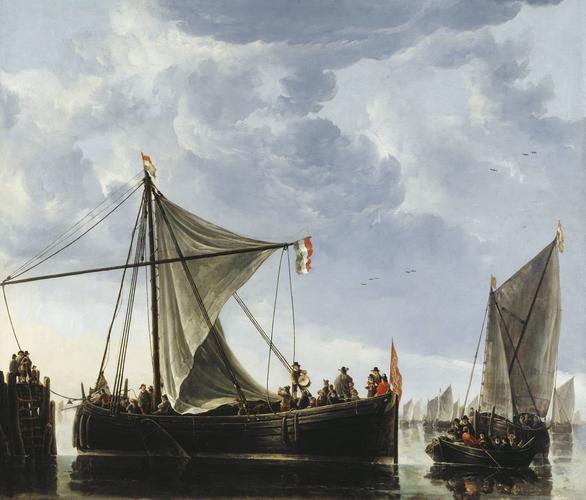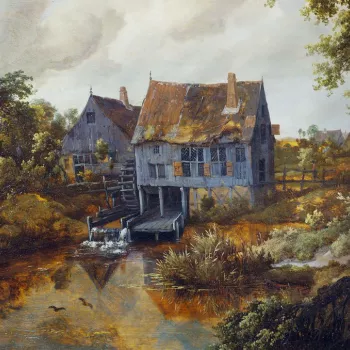The Passage Boat c.1650
Oil on canvas | 124.0 x 144.4 cm (support, canvas/panel/stretcher external) | RCIN 405344
-
A ‘passage boat’ is an old-fashioned word for a ferry: this one is probably the regular passenger service between Dordrecht and Rotterdam, part of the network of waterborne public transport which was such a remarkable feature of life in seventeenth-century Holland. This vessel is a pleyt – a single-mast, sprit-rigged, shallow draught, broad-hulled tub, very similar to a smalschip – adapted to carry large numbers of passengers slowly in calm inland waters. The two pleyten here are made to look as if successive views of the same vessel and show how the sail is lowered as the boat drifts towards the jetty. A drummer announces the arrival of the service and a man fends off with a bargepole. This is a remarkably large scale image of a boat, but there is nothing remarkable about the boat itself or the function it is performing. There are some burghers aboard the pleyt and the rowing-boat but no obvious dignitary; there are many ships in the background but nothing to suggest that this is a review of the Dutch fleet. What we see here is literally a daily occurrence.
The drama of presentation here does not just depend upon the isolation of the ferry and its scale. The water-skimming viewpoint means that the hull stands out against the horizon, which glows like a halo as the setting sun catches the mist coming off the sea; it also pushes the mast up into the clouds. These clouds are shaped rather like those in Rembrandt’s Three Trees (British Museum) to suggest the forms of angels or zephyrs surrounding the light of the sky. Hoogstraten later advises artists to ‘Observe the lovely gliding of the clouds, and how their drift and shapes are related to one another, because the eye of the artist must always recognise things by their essence while the common folk see only weird shapes.’
‘Peopled clouds’ were familiar from allegorical prints, like that depicting the Dutch ‘ship of state’, produced in 1620 to celebrate the Synod of Dordrecht (1618-9). This Passage Boat appears too ordinary to be a ‘ship of state’, yet the image carries the same visionary enthusiasm. This is probably intended to be a more private allegory of salvation of the type which a spiritual person reads in the ordinary fabric of the world. It would certainly be unlikely for a contemporary viewer to look at this boat without noticing that the mast and sprit-pole make a cross.
Signed on the rudder: A. cüypProvenance
Purchased by George IV from Sir Thomas Baring as part of a group of 86 Dutch and Flemish paintings, most of which were collected by Sir Thomas’s father, Sir Francis Baring; they arrived at Carlton House on 6 May 1814; recorded in the Blue Velvet Room at Carlton House in 1819 (no 48), where it appears in Pyne's illustrated Royal Residences of 1819 (RCIN 922184); in the Picture Gallery at Buckingham Palace in 1841 (no 23)
-
Medium and techniques
Oil on canvas
Measurements
124.0 x 144.4 cm (support, canvas/panel/stretcher external)
158.0 x 179.0 x 9.5 cm (frame, external)
Other number(s)











